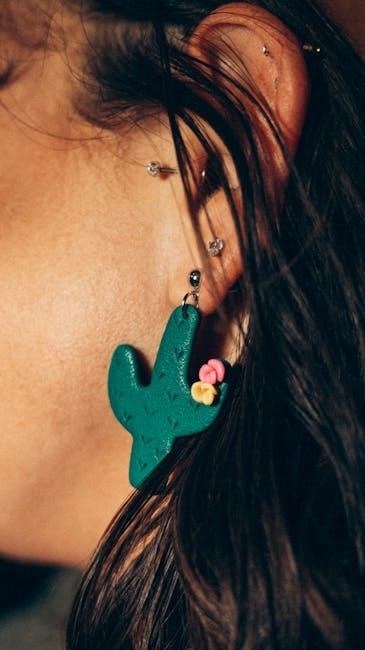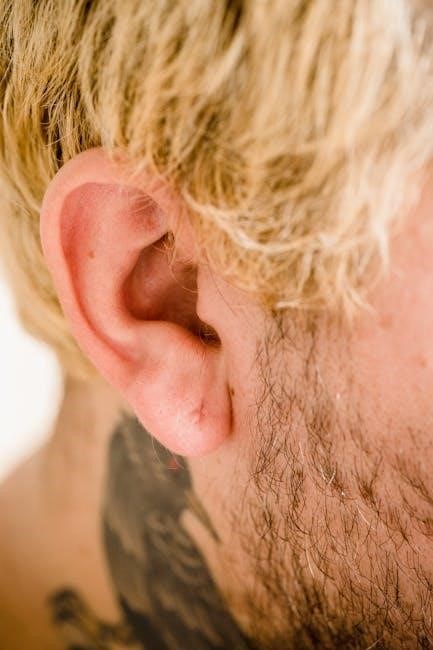piercing guide ear
Ear piercing is a timeless form of self-expression, offering a way to enhance personal style. It involves creating a hole in the earlobe or cartilage, allowing jewelry to be worn. With proper care, it can be a safe and rewarding experience, though it’s important to understand the process and aftercare requirements to ensure optimal healing and results.
1.1 What is Ear Piercing?
Ear piercing is the practice of creating a hole in the earlobe or cartilage to wear jewelry. It involves using a needle or piercing gun to puncture the tissue, allowing for the insertion of earrings or studs. This popular form of body modification is both a cultural and personal expression, with various styles and placements available. The process is typically quick but requires precision to ensure proper placement and minimize discomfort. Ear piercing is a simple yet meaningful way to enhance one’s appearance and showcase individuality through jewelry choices.
1.2 Benefits and Considerations
Ear piercing offers a unique form of self-expression and can boost confidence through personalized jewelry choices. It is a relatively safe procedure when done professionally, though it requires commitment to aftercare. Considerations include the healing time, potential discomfort, and the importance of maintaining hygiene to prevent infections. While ear piercing is popular, it’s essential to weigh the benefits of aesthetic enhancement against the responsibility of proper care and the cost of quality jewelry. Understanding these factors helps ensure a positive experience and lasting satisfaction with your piercing.

Types of Ear Piercings
Ear piercings are categorized into two main types: earlobe and cartilage piercings. Both are popular for their unique characteristics and aesthetic appeal, offering diverse styling options.
2.1 Earlobe Piercing
Earlobe piercing is the most common and popular type, involving piercing the soft, fleshy tissue of the earlobe. It’s relatively painless and heals quickly, typically within 6-8 weeks. The procedure can be done using a piercing gun or a hollow needle, with the latter often preferred for its precision. The earlobe is versatile, accommodating various jewelry styles, from studs to hoops. Proper aftercare is essential to prevent infections and ensure smooth healing. This piercing is a great starting point for beginners due to its simplicity and low maintenance requirements.
2.2 Cartilage Piercing
Cartilage piercing involves creating a hole through the tougher, cartilaginous tissue of the upper ear. This type of piercing is more intricate than earlobe piercing and typically takes longer to heal, often requiring 3-6 months. It’s essential to use a hollow needle for precision and to minimize discomfort. Cartilage piercings are popular for their unique aesthetic and versatility in jewelry styles. Proper aftercare is crucial, as cartilage piercings are more prone to complications if not cleaned regularly. This piercing offers a stylish way to enhance your look, though it may be slightly more delicate than earlobe piercings.
The Piercing Process
The piercing process involves preparation and execution by a professional. They clean the area, mark the spot, and use a sterile needle or piercing gun to create the hole. Aftercare instructions are provided to ensure proper healing, emphasizing cleanliness and avoiding irritants like swimming in pools. This step-by-step approach ensures safety and minimizes risks, making the experience smooth and stress-free for those getting their ears pierced. Professional piercers prioritize hygiene and precision for optimal results and client satisfaction;
3.1 Preparation
Preparation is crucial for a safe and successful ear piercing. Start by ensuring the area is clean and free of bacteria. A professional piercer will typically clean your ear with an antiseptic solution and mark the desired spot. Sterilize the equipment, including the needle and jewelry, to prevent infection. Choose your jewelry in advance, ensuring it’s made from high-quality, hypoallergenic materials. Wash your hands thoroughly before handling the piercing area. Discuss any concerns or allergies with your piercer to ensure a smooth process. Proper preparation minimizes risks and ensures a positive experience.
3.2 The Piercing Procedure
The piercing procedure typically begins with the piercer cleaning the ear with an antiseptic solution to ensure a sterile environment. A mark is made where the piercing will be placed, and the piercer uses a sterile needle or piercing gun to create the hole. For professional piercings, a hollow needle is often preferred as it causes less trauma. Once the hole is made, the jewelry is carefully inserted and secured. The process is quick, but precision is key to ensure proper placement and minimize discomfort. Professional piercers follow strict hygiene protocols to ensure safety and success.
Aftercare and Healing
Proper aftercare is essential for healing and preventing infections. Clean the piercing regularly with saline solution, avoid touching it unnecessarily, and keep the area dry to promote smooth recovery.
4.1 Daily Cleaning Routine
A consistent daily cleaning routine is crucial for proper healing. Begin by washing your hands thoroughly with soap and water. Gently spray a sterile saline solution on both the front and back of the piercing, 2-3 times daily. Avoid using harsh chemicals or submerging the piercing in water, such as swimming in pools or oceans, as this can introduce bacteria. Use a clean, non-woven gauze or cotton ball dampened with saline solution to dab the area, ensuring no residue or discharge remains. This routine helps prevent infections and promotes a smooth recovery process.
4.2 What to Avoid During Healing
During the healing process, it’s essential to avoid certain activities to prevent complications. Refrain from swimming in pools, oceans, or hot tubs, as bacteria in the water can cause infections. Avoid touching the piercing without clean hands, as this can introduce germs. Do not remove or change jewelry prematurely, as this can disrupt the healing process. Tight clothing that irritates the area should be avoided, and avoid playing with or twisting the jewelry excessively, as this can lead to irritation and delay healing. Additionally, smoking and stress can slow recovery, so it’s best to minimize these factors.

Choosing the Right Piercer
Selecting a skilled and reputable piercer is crucial for a safe and successful experience. Look for a piercer with extensive experience and positive reviews. Ensure they use sterilized equipment, such as hollow needles, and maintain a clean, hygienic environment. Avoid piercers who use piercing guns, as they can cause more trauma to the tissue. A professional piercer will guide you through the process, answer questions, and provide aftercare instructions. Always observe the studio’s cleanliness and ask to see their sterilization procedures before committing. Proper technique and hygiene are key to minimizing risks and ensuring proper healing.
Jewelry Options for Ear Piercings
Starter jewelry includes studs or hoops made from surgical steel or titanium, ideal for healing. Upgrade to gold, silver, or gemstone pieces once fully healed for personalization.
6.1 Starter Jewelry
Starter jewelry is specifically designed for new piercings, prioritizing comfort and safety during the healing process. Typically, studs or hoops made from high-quality, hypoallergenic materials like surgical stainless steel or titanium are recommended. These metals minimize the risk of allergic reactions and promote smooth healing. The jewelry should have a simple design without intricate details that could trap bacteria. Properly fitted starter jewelry ensures the piercing remains clean and allows for optimal airflow, which is crucial for preventing infections and facilitating a quick recovery.
6.2 Upgrading Your Jewelry
After the piercing has fully healed, typically within 6-12 weeks for lobes and longer for cartilage, you can upgrade to various jewelry styles. Popular options include dangling earrings, huggies, and threader earrings. When choosing new jewelry, opt for materials like solid gold, platinum, or implant-grade titanium to ensure biocompatibility. Consider the piercing location and personal style when selecting designs. Upgrading allows for personalization, enhancing the aesthetic appeal of your piercing while maintaining comfort and durability. Always ensure jewelry is properly secured to avoid losing it and to keep the piercing intact.
Common Mistakes to Avoid
- Touching the piercing excessively, which can introduce bacteria and delay healing.
- Removing jewelry too soon, as this can cause the hole to close or lead to complications.
- Using low-quality or inappropriate jewelry materials that may irritate the skin.
- Ignoring aftercare instructions, such as skipping daily cleaning or submerging the piercing in water too early.
- Not waiting the recommended healing time before changing jewelry or experimenting with styles.
- Using harsh cleaning products that can irritate the piercing or slow down the healing process.
Healing Times and Stages
Ear piercings heal in stages, starting with inflammation and ending with a fully healed hole. Immediate aftercare ensures proper healing, typically taking 3-6 weeks for lobes, longer for cartilage.
8.1 Immediate Aftercare
Immediate aftercare is crucial for proper healing. Clean the piercing twice daily with sterile saline solution, gently spraying both front and back. Avoid submerging the piercing in water, such as swimming in pools or oceans, to prevent infection. Keep the area dry and avoid tight clothing that may irritate the piercing. Refrain from touching the piercing unless cleaning, and always use clean hands. Follow the piercer’s specific instructions to promote healing and minimize complications during the initial recovery phase.
8.2 Long-Term Healing
Long-term healing requires consistent care beyond the initial phase. Keep starter jewelry in for at least 6 weeks, avoiding tight clothing that may irritate the area. Refrain from removing earrings during this period, as this can lead to complications. Once healed, you can safely change jewelry, but always follow your piercer’s advice. Healing times vary, but proper aftercare ensures a smooth process. Maintain cleanliness and avoid harsh products to support the healing journey and achieve the best results for your piercing.
Managing Infections and Complications
Managing infections and complications is crucial for maintaining the health of your ear piercing. Signs of infection include redness, swelling, or pus. If symptoms persist, use a saline solution to clean the area and avoid irritants like tight clothing or harsh products. Avoid swimming in pools or oceans, as bacteria can worsen the infection. Seek professional help if symptoms don’t improve, as severe cases may require medical attention. Always follow proper aftercare to prevent infections and ensure a smooth healing process.

Personalizing Your Piercing
Personalizing your piercing involves choosing unique jewelry styles and placements that reflect your personal aesthetic. Consider your face shape, lifestyle, and desired look to create a balanced, stylish appearance.
10.1 Placement and Symmetry
Placement and symmetry are crucial for a polished look. Mark the spot carefully to ensure balance, especially for multiple piercings. Symmetrical piercings create harmony, while asymmetrical designs offer a trendy vibe. Consider your ear shape and face symmetry to choose the best placement. Using a mirror, mark dots to guide the piercer, ensuring alignment. Proper placement enhances aesthetics and prevents uneven healing. Communication with your piercer is key to achieving your desired look and maintaining balance.
10.2 Aesthetic Considerations
Aesthetic considerations play a significant role in ear piercing, as they influence personal style and overall appeal. Choose jewelry that complements your ear shape and face symmetry. Studs and hoops are popular for their versatility, while dangling earrings add flair. Consider the thickness of your earlobe or cartilage when selecting jewelry size. Personal style, whether minimalist or bold, should guide your choices. Current trends, like multiple piercings or unique placements, can enhance your look. Balancing aesthetics with comfort ensures a piercing that suits your lifestyle and complements your features beautifully.

Setting Up a Daily Care Routine
Establishing a consistent daily care routine is essential for maintaining healthy and attractive ear piercings. Begin by washing your hands thoroughly before touching your piercings. Gently clean the front and back of each piercing with a sterile saline solution, 2-3 times daily. Avoid harsh chemicals or excessive touching, as this can irritate the area. Keep the jewelry clean and secure, ensuring studs are tightly screwed on. Regular cleaning prevents infections and promotes healing. Consistency is key to keeping your piercings looking their best and ensuring long-term comfort and appeal.
When to Change Your Jewelry
It’s important to wait until your piercing is fully healed before changing your jewelry. For earlobe piercings, this typically takes 6 weeks, while cartilage piercings may require 12 weeks or more. Avoid changing jewelry too soon, as this can disrupt the healing process and lead to complications. Once healed, you can explore various jewelry styles, ensuring they fit comfortably and suit your aesthetic preferences. Always clean your hands and the piercing area before handling the jewelry to maintain hygiene and prevent infections.